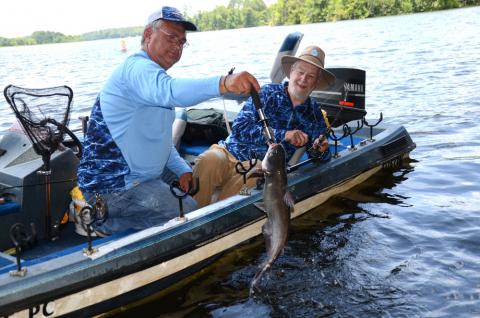Richard Hines | Originally published in GameKeepers: Farming for Wildlife Magazine. To subscribe, click here.
If you are new to the world of wood cutting you might be overwhelmed when you start looking at different types of chainsaws. As a friend said, “It’s as confusing as picking a good bird dog out of a 10-pup litter.” Without getting into which brand is best, choosing a saw gets down to the type of jobs you are planning to do, plus you need to honestly consider your physical ability and previous experience with chainsaws. If you are a gamekeeper there’s a good bet you will need a chainsaw sometime during the year.
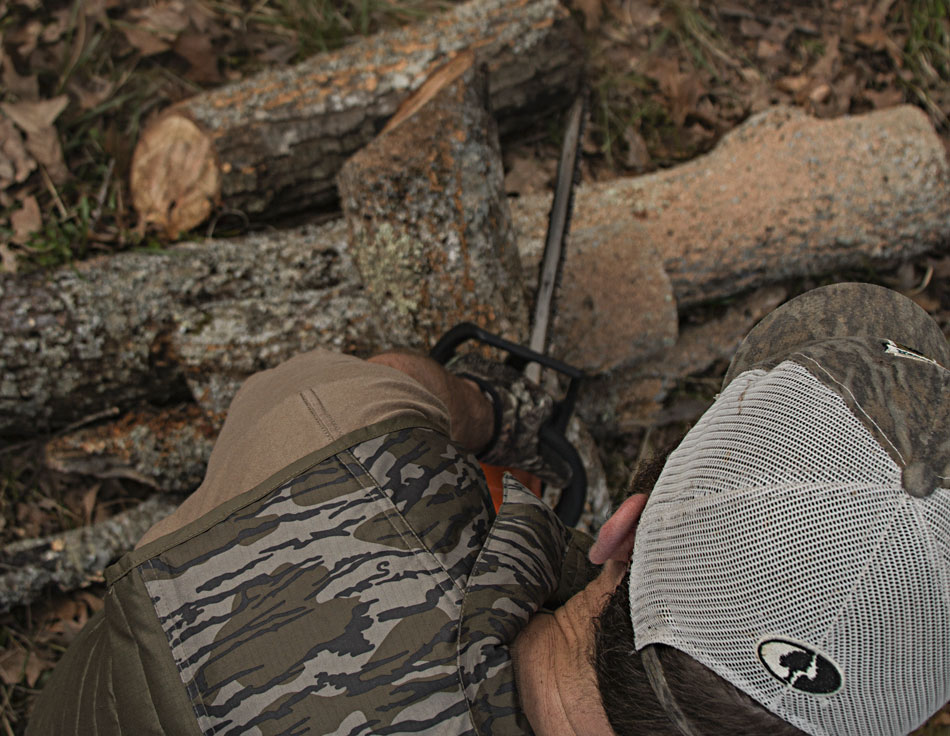
The jobs you have planned can be simple; cutting some wood for the cabin stove or trimming low limbs along a shooting lane. These small jobs don’t really require large saws, but as you go up in tree sizes you need to look at larger “farm grade” saws. And as you move up again, assess your skill, physical ability and what you plan to cut.
As an example, my wife and I own 217 acres. Except for 35 acres of pastures and scattered food plots most of our property is woodland. Even with this acreage of woodland I keep most of my wood cutting to the smaller size classes of trees; under 18 inches, although I recently cut several trees that were 20 inches dbh (diameter breast height). These trees were dying and I wanted to take them down before summer. Invariably trees always wait to fall when I am mowing my pastures or food plots so I try to stay ahead of potential problem trees by dropping them between hunting seasons.
With four miles of access trails I also spend a fair amount of time cutting downed trees or overhanging limbs on trails. As time permits I cut an occasional load of cedar trees that we sell to a local saw mill. Over the past few years I have harvested pine, cherry or walnut trees that a friend cut on his bandsaw mill into lumber for my workshop. While I have larger trees, I do not plan to cut them. They will be left for professional loggers when the time comes. I use a Stihl Farm Boss 291. At 65 years old, I consider this “farm grade” saw with an 18-inch bar sufficient for any cutting I plan to do. It makes little sense to lug around a large saw if you never have a need for the bigger size.
To find out how a dealer matches a person to the saw I stopped by my local farm supply store; MFS which is operated by Barney Withers. He told me, “I kind of size people up when they come in asking for a saw.” Withers said, “There’s no problem with loggers, as these professionals know what they need, but many new saw buyers are just not sure. We have many ladies who use saws, but they may need a smaller saw. Also, if a buyer has a bad shoulder, there are saws with the easy pull feature.” He also asks them how much sawing they are planning to do and how long each day will they operate the saw? Then Withers will match the correct saw for that person.
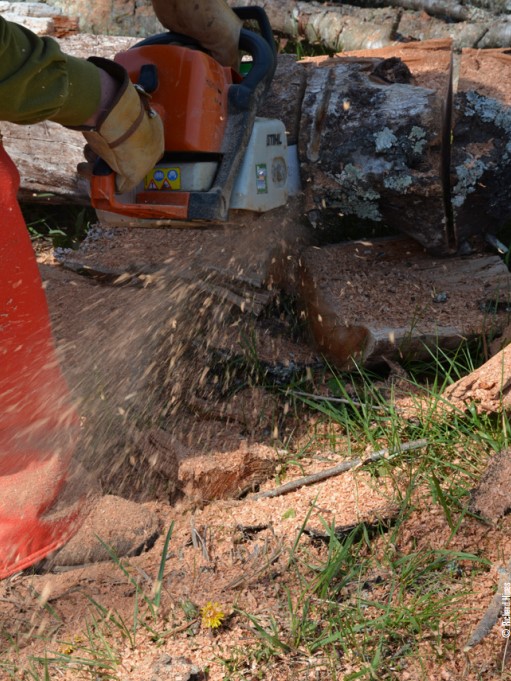
more dust than chips it’s probably time to change-out a new chain or
sharpen the existing one. Having a couple chains for the same saw so you
can rotate them will keep you on the job when one dulls.
Rick Bellew is the Midwest Sales Manager at Bryan Equipment, also emphasized going to a “servicing dealer” when choosing a saw. Like Withers these dealers are trained and know how to match the saw for the job and the person’s ability.
Once you have determined which saw you will need, Bellew suggested buying something a little bigger. He said, “If you were going to purchase a 2 hp go to a 2.5 hp, invariably people get used to their saws and then try to do more. You are really safer with a saw with more power than not enough.” The worst thing that could happen is being in the middle of the cut when the saw bogs down or dies.
So, does size matter…or as sawyers say “how long is your bar?” Bellew said, “It’s not the bar, but the power your saw has to pull the chain. Over the years, I have noticed that many big box stores sell saws with “big bars,” but when looking at the power there is no way the saw has enough power to pull the chain. For years, I did contract Timber Stand Improvement and for the better part of eight hours I carried a saw cutting tree after tree. On normal days, I would run several tanks of fuel through the saw. If you are anticipating this type of work, the anti-vibration feature is a good idea and running a saw this long should require something in the professional grade, but these are heavier and you need to be in good physical shape.
For those small jobs around the cabin, Withers suggested the Stihl MSA-200C-BQ which is a Lithium battery powered chainsaw. To tell you the truth, I was a little reluctant so he loaned me one for the weekend. After carrying it around on a friend’s hunting lease we starting cutting limbs along access trails and we were very surprised. The saw not only cut small limbs, but we dropped several 6 and 7 inch dbh cedars. The Stihl 200 handled every tree just fine. Obviously, you must keep the chain sharp like any other saw and the Stihl 200 also uses chain oil.
As far as safety features go, we still wore gloves and glasses, but when you let off the trigger the chain stops immediately. The Stihl 200 is by no means a toy and should be treated as such. Generally, the long-lasting lithium battery will cut 100 four inch logs or give you 35 minutes of “trigger time.” That’s all we needed to use it off and on for two days.
Another good point - if you transport the saw in an SUV there are no fuel odors to deal with. It’s lighter than my regular saw and I see the “200” as a nice tool for carrying to the stand for cutting larger limbs or trees in shooting lanes, plus it’s quieter than a regular chainsaw!
PPE or “Personal Protection Equipment” (the gear that keeps you safe!)
There are several essential pieces of PPE. One is a helmet and if you have doubts about helmets, just ask Wildlife Biologist Jef Hodges. With 30 years’ experience under his belt you would think nothing could go wrong, but he still made a mistake that almost cost him his life. Hodges was working on his farm and cut a 20-inch tree that made a turn on him. As he was moving away from the tree it crashed on him. As Hodges said, “I can run 40 feet in the same amount of time it takes a 60-foot tree to hit the ground!” He was knocked out and his hardhat was cracked. Experts said the hardhat did its job as planned. It absorbed the shock. Hodges said, “If I had just thought about how I was cutting the tree, the accident could have been avoided.” He said “for sure without the hardhat the tree would have killed me.”
If you purchase a hardhat go ahead and get a chainsaw helmet from your dealer. It will have combination ear protection and a face screen. Safety glasses are another essential item.
If you like your legs; get chaps. Hodges said, he won’t start a saw without them. Bellew said his favorite quote is, “I don’t need chaps because I have never been cut.” Bellew said that’s why you need chaps!
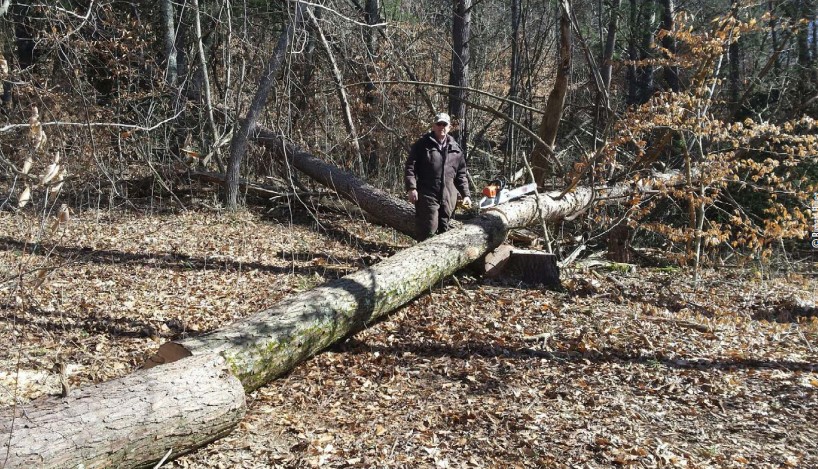
You don’t really need logger boots but never start a saw wearing tennis shoes. Boots are a must and preferably steel-toed. I also wear leather gloves. Now if all of that seems excessive to just cut a little tree, think about this. Chains are running from 9,000 to 16,000 rpm and a kick back could come at you at 50 miles per hour.
Other safety items can be found on saws which are much improved over the years. One very important feature is the chain brake. These are a MUST as it will stop the chain within 1/10 of a second. This feature is not required and some cheaper saws will only have a hand guard but this will NOT stop the chain.
There are also anti-vibration features on saws which will reduce fatigue which is one of the leading causes of injury. When you get tired you make mistakes. The tip of the saw hitting something will cause the saw to kickback, so many new saws have a reduced kickback bar and chain. If you are a new sawyer, purchase this feature until you are more comfortable handling the saw. Many pros do various cuts that the kickback feature prevents; however, if you are new to chainsaws these are cuts you should not attempt yet.
Above all, get instructions from the dealer and read the operator’s manual. I know guys are not supposed to read the operator's manual, but sometimes it’s good to do especially with a new saw and a tool that could easily remove one of your appendages.
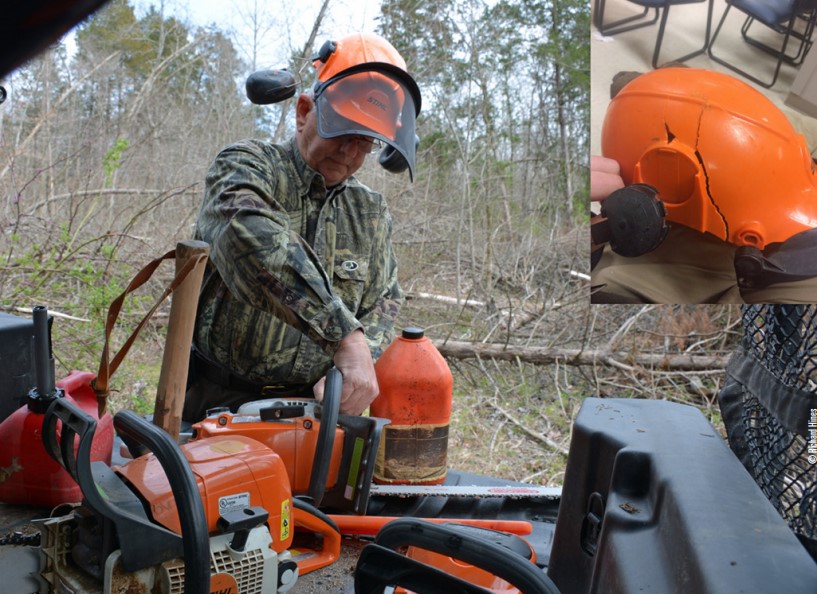
After you purchase your saw find out what you will need to maintain it. One thing you will need to do often is to sharpen the chain. Stihl makes a file guide that keeps the correct angle. Chains that are manufactured today must be sharpened exactly. In fact, if the angle of the chain is off just one degree it can affect the saw’s performance. These guides help.
And you never think about a sharp chain as being a safety feature, but as the chain gets duller you will notice yourself doing more pushing/pulling. I generally sharpen chains when I notice extra vibration or slower cutting. Letting the chain get dull will wear you down which can create more potential for accidents. A good standard says your chain should be cutting about an inch of wood per second!
When sawing, take breaks. If I run a tank of fuel through the saw this is time to not only refuel the saw but refuel me as well. Depending on the temperature and humidity levels I prop up against a tree and take a nice water break for fifteen minutes or so which will help me get my energy level back up.
Before cutting a tree I always evaluate every tree by stepping back and looking at the top with the following questions. Is the top dead, are there vines connected to other trees or snags, are there cracks along the bole (trunk), where is the weight distributed? Mushrooms growing on the side of the tree may indicate rot, and rotten trees may not fall as you expect them to. Finally, I make sure I have an escape route in case something goes wrong. An escape route should be behind the direction you are felling and at a 45-degree angle. If it doesn’t look safe, the tree can stay. You should know your capability and stay within it. Again after 40 years of woodland work I have learned when to leave a tree in the woods.
For my daily operations I keep my “chainsaw tools” in a five-gallon bucket including wedges, chainsaw wrench/ screwdriver and an ax just in case I hang or pinch a saw, and trust me after having cut thousands of trees over the past 40 years you will hang saws in trees.
At the end of year, gamekeepers should be thinking about maintenance by checking the bar and chain. Go ahead and oil the chain and chain brake, plus clean the air intake slots. If the bar is beginning to wear consult the operator’s manual about rotating the bar. At this point I may also consider replacing the chain so it will be ready next time you use. If I am going to store the saw all winter I would also drain the gas and oil completely.
Taking time to visit a dealer who is a professional servicing center will not only match your ability and skill with the perfect saw, but they can instruct you on how to maintain your saw so that it lasts many years.

















